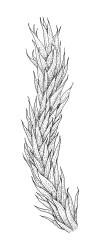- ≡ Pleuropus Griff., Calcutta J. Nat. Hist. 2: 473 (1842) nom. illeg.
Plants medium-sized to robust, forming loose green, yellow-, brown- or pink-green mats, or pendent, rigid and glossy when dry. Stems elongate and creeping, with numerous bundles of rhizoids, fastigiately or subpinnately branched, in cross-section with a strong central strand and 2–4 layers of thick-walled cortical cells. Branches short or elongate, ascending or pendent. Stem and branch leaves not differentiated, crowded, erect-spreading, often secund, little differentiated when dry, gradually lanceolate from an ovate base, strongly plicate, with margins plane above and recurved below, serrate above, serrulate below, not decurrent. Costa unbranched and ending below the leaf apex. Upper laminal cells smooth, thin- or firm-walled, oblong-linear to flexuose-linear, porose, becoming shorter and more porose near leaf base; alar cells ± quadrate in rather large groups.
Dioicous. Perichaetial leaves elongate, abruptly or gradually subulate. Setae elongate, reddish, thin, smooth; capsules erect, symmetric, cylindric, smooth; exothecial cells variable in shape, mostly rectangular; annulus differentiated; operculum rostrate from a conic base. Exostome teeth cross-striolate or smooth below and papillose above, ± trabeculate; endostome free, yellowish, with a high basal membrane; segments rather irregular and keeled, perforate or not; cilia rudimentary or absent. Calyptra cucullate, smooth. Spores small, finely papillose.
A small genus of three species of wide but scattered distribution in tropical and temperate regions. One species occurs in N.Z. Representatives of Palamocladium were first recorded here by Bartlett (1984). Hofmann designated the Indian Pleuropus fenestratus Griff., a heterotypic synonym of Palamocladium leskeoides, as the lectotype of Palamocladium.
The genus was monographed by Hofmann (1997), who noted that the three species (which do not overlap geographically) cannot be confidently distinguished in the absence of sporophytes. She did not, however, express reservation about her assignment of N.Z. material to P. leskeoides, which is the most widespread of the three species. According to her discussion and key, P. leskeoides is mostly reliably distinguished from its congeners by an absence of perforations in the endostome segments, the presence of cross-striolations or striations on the lower parts of exostome teeth, and the number of short exothecial cells present at the capsule mouth. She reported all three species of Palamocladium to be dioicous, and to produce both normal-sized and dwarf male plants.
The relationship between Palamocladium and Homalothecium Schimp. is controversial, and some authors (e.g., Robinson 1962) have submerged Palamocladium into the latter genus. Hofmann (1997, 1998) is the most recent monographer of both these genera and her decision to retain Palamocladium is followed here. The characters used traditionally (vide Brotherus 1925) to differentiate the genera Palamocladium and Homalothecium include the ornamentation of the setae, the degree of leaf margin serration, capsule symmetry, and the density of rhizoids. Modern regional Floras that treat the two genera as distinct include Crum & Anderson 1981, Noguchi 1987–1994, and Lai et al. 1991. The separation of the two genera appears to be well supported in the phylogenetic analysis of Ignatov & Huttunen (2003, fig. 2).
| Category | Number |
|---|---|
| Indigenous (Non-endemic) | 1 |
| Total | 1 |




